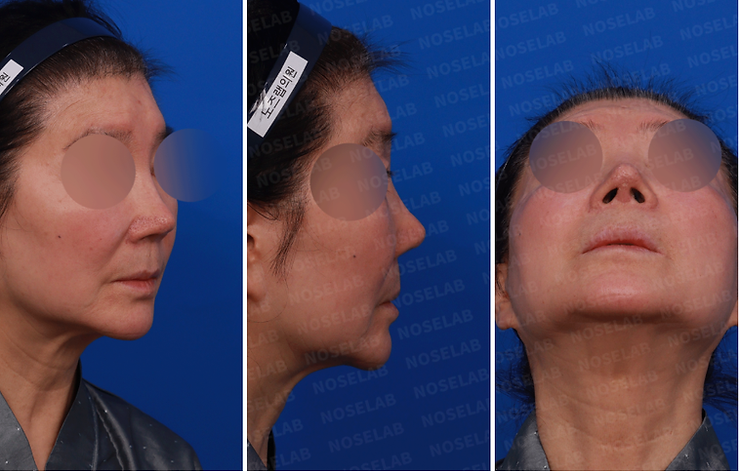[Nose Lab Clinic]
Hello, this is Dr. Cha-Young Kang, Director of Nose Lab Clinic.
Today, I’d like to share a unique case of a senior patient with a 50-year history of nasal surgeries.
This patient required a revision to address both aesthetic and functional issues, while ensuring safety due to underlying health conditions. Here's a detailed look at the approach and results.
1. Underlying Conditions and Medications
Arrhythmia
Hyperthyroidism
Hyperlipidemia
Medications: Antihypertensives, thyroid medication
2. Surgical History
50 years ago: L-shaped silicone implant (dislodged due to trauma, protruding through the columella).
30 years ago: Silicone implant revision.
3–4 years ago: Silicone implant, ear cartilage, and septal cartilage used.
3. Patient Concerns and Goals

Design Consultation: Frontal View, Left Side View, and Oblique Side View Photos
High, straight nasal dorsum.
Balanced and voluminous nasal line.
Harmony with facial proportions.
Left nostril pain relief.

Design Consultation: Right Oblique Side View, Side View, and Nostril View Photos
4. Preoperative Analysis

Before (Left) / Immediately After (Right)
a. Frontal View:
Sharp nasal tip.
Asymmetric nostrils.
Deviated nose (leftward).
Uneven dorsal contour.

Before (Left) / Immediately After (Right)
b. Side View:
Overly pointed nasal tip.
Artificial-looking dorsum.
Upturned nose.
Protruded lips.
Long philtrum.

Before (Left) / Immediately After (Right)
c. Nostril View:
Asymmetric nostrils.
Leftward-tilted columella.

Before (Left) / Immediately After (Right)
5. Surgical Plan and Considerations
Given the patient’s advanced age and underlying conditions, the surgical plan prioritized safety:
Donor rib cartilage was chosen to minimize surgery time and complexity.
Surgery was conducted under the supervision of an anesthesiologist.
Stability and structural integrity were key goals.
6. Intraoperative Findings
Contrary to the patient’s surgical history, donor rib cartilage was previously used for the nasal tip. This cartilage was fixed to the septum at the location corresponding to the reported pain. The fixation point was identified as the source of discomfort.
Steps Taken:
Removed the problematic donor cartilage.
Replaced with new donor rib cartilage.
Repositioned and securely fixed the cartilage to a different location for improved comfort and stability.
7. Results

Immediately After Surgery: Frontal, Side, and Oblique Side View Photos
a. Frontal View Improvements:
Balanced nasal volume with natural contours.
Corrected nostril asymmetry.
Straightened nasal alignment.
b. Side View Enhancements:
Improved drooping tip.
Rounded, soft nasal tip.
Natural nasolabial angle.

Immediately After Surgery: Nostril View Photos
c. Nostril View Adjustments:
Symmetrical nostril shape.
Straightened columella.
8. Expert Insight
As we move into an era where more senior patients are considering cosmetic procedures, safety becomes paramount. For elderly individuals, surgical planning must account for the increased risks of anesthesia and healing complications. Close collaboration with anesthesiologists and a tailored approach are essential.
This case underscores the importance of careful evaluation, even for patients with extensive surgical history. Addressing both functional concerns (such as pain relief) and aesthetic goals is critical for achieving satisfaction in such complex cases.
At Nose Lab Clinic, we prioritize patient safety and customized solutions for all age groups.
Thank you for reading this case study. We hope it provides valuable insights, especially for those considering revision surgery in their senior years.
This is Dr. Cha-Young Kang from Nose Lab Clinic.
Thank you.


Comments